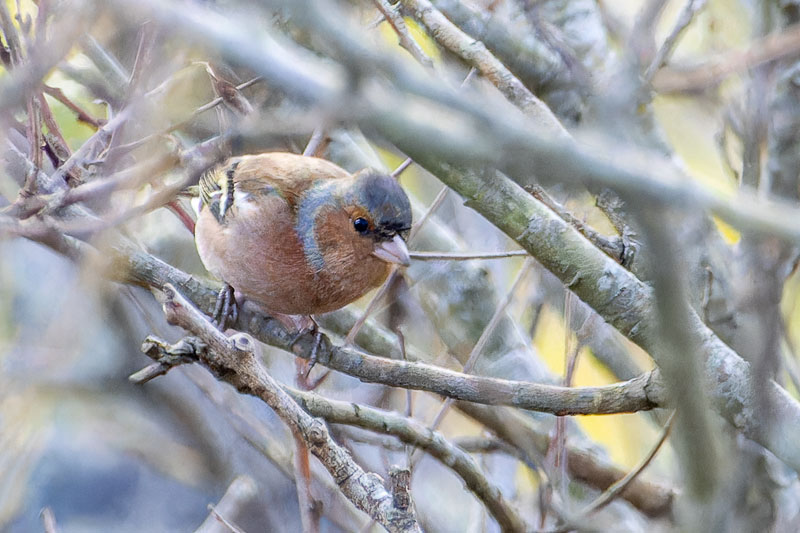Today looked, felt and even smelled like spring. Right after jumping out of the car, I realised wearing a long-sleeved sweater would soon make me sweat and that was not the ideal circumstances for a trip on foot that was about to last several hours. A simple T-shirt would be enough on my visit to the area around the Celemin river, during which I was mainly on the lookout for the Great Spotted Cuckoo, a wonderful bird that had been observed in this area around this time of year several times.
From the very beginning I had the feeling that on this excursion I would observe a lot of species. Songbirds were the first species I noticed right after leaving the car near the entrance gate to the Celemin Reservoir, an area which I would like to explore more in the future, after figuring out how to access it in the most discreet way possible.
 |
| Chaffinch at the beginning of my walk |
As is often the case with songbirds living in an area full of trees and branches, most species here were rather heard than seen. A real symphony of cheerful chatter accompanied me along the river with a view on the nearby dry rice fields. |
| Great Tit |
I didn't only see songbirds but also an interesting numbers of birds of prey, like Marsh Harrier, Griffon Vulture, Buzzard, Peregrine Falcon and Red Kite, quite an impressive range of different species. |
| Red Kite |
 |
| Several Red Kites soaring through the sky together at relatively high altitude |
 |
| Marsh Harrier flying low over the fields |
 |
| Jackdaw cleaning up roadkill |
I did not manage to get very close to the birds, instead I decided to take some photos showing birds in their natural surroundings.
 |
| Grey Heron in the rice fields |
One memorable moment of this walk was definitely when I spotted a Little Egret hunting in the rice fields. I am still not sure what it caught, but is was huge and went in very easily. |
| Little Egret catching a great snack |
 |
| … not sure what it was … |
 |
| … but in it went! |
Apart from flocks of European Serins, a very present bird was the Corn Bunting, singing on posts, in trees as well as on power lines.
 |
| Corn Bunting |
Slightly to my frustration, a lot of birds were quick as a flash and therefore almost impossible to photograph, but I managed to capture a Cirl Bunting, a species I don't hardly see. |
| Cirl Bunting |
 |
| A Meadow Pipit singing its lungs out |
 |
| Nearby rice fields |
 |
| Another Little Egret taking to the air |
The final part of today's walk was without a doubt the most boring, or that's what I initially thought. It is a straight road with fields on both sides and little to hear or see apart from some Greenfinches and European Serins. Fortunately I spotted a Common Kestrel that was on a hunt for food. Although I already have tons of pictures of these charismatic birds hovering in the sky, I decided to follow one of them, ready to capture any special moments if they would occur.
 |
| Kestrels are very agile hunters |
 |
| Hovering male Kestrel |
I am thankful I was so patient: I captured a female Kestrel split seconds before catching a flying bug in mid-air!
 |
| Female Kestrel stretching out her claws to catch a flying insect |
 |
| Tasty snack! |
Patience sometimes pays off! And occasionally, well, you have to be lucky. I heard the call of a Spanish Imperial Eagle! I had seen this species only once before, during a visit to nearby La Janda. With a wingspan of over two metres, these giant raptors are a truly spectacular sight. I could barely believe my eyes, because I was looking at a pair of these magnificent hunters. Yes, two of them! To make things even more breath-taking, the birds decide to perch in a tree in a nearby field. Even at a distance of two hundred metres, I managed to take some memorable shots. |
| A pair of Spanish Imperial Eagles! |
These rare birds are mostly seen in flight, and taking their photo landing on the canopy of a tree was a magical moment. Technically the photos could have been much better, due to the fact that I was photographing against the light and also because of the mere distance. Could it be worth spending a whole afternoon some other day, wearing my ghillie suit and entering private land, possible home to brave bulls? Very tempting, I must admit!
Finally, on my way back to my starting point, I used my tele photo as a macro lens. The Sigma 150-600 is really versatile, but I am looking forward to using a real macro lens soon.
 |
| Sings of early spring! |
No sign of the Great Spotted Cuckoo today, but hey... can't complain after observing almost fifty different species including a pair of Spanish Imperial Eagles!
Henry.























